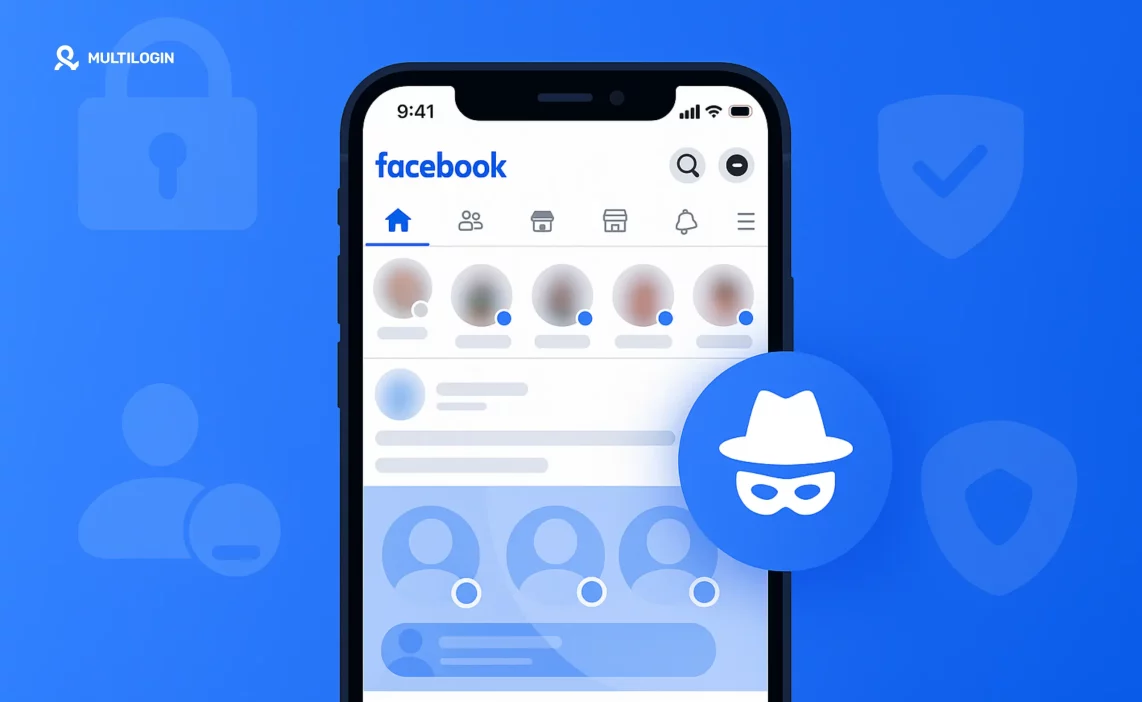Ever wished you could browse Facebook anonymously—peeking at profiles, pages, or groups without anyone knowing you were there? You’re not alone! Every month, thousands of people look for the perfect anonymous Facebook browser to keep their curiosity under wraps.
Whether you’re a recruiter, a job seeker, a competitor, or just someone valuing their privacy, Facebook’s real-name policies and tight data tracking can make true anonymity feel impossible. With the rise in privacy concerns and tracking scandals, the desire for Facebook anonymous browsing has never been higher.
So—can you browse Facebook anonymously in 2025?
Let’s uncover the truth about Facebook privacy, and how you can finally browse Facebook anonymously—no matter your goal.
Can You Browse Facebook Anonymously? The Truth in 2025
Let’s get straight to it: Can you browse Facebook anonymously? The answer is… sort of, but with big limitations. Here’s what you need to know before you search for an “anonymous Facebook browser.”
What Facebook Tracks by Default
- Profile Views: Unlike LinkedIn or Instagram, Facebook does not notify users of who views their profile or timeline. However, your actions—likes, comments, friend requests—are always visible to the profile owner.
- Cookies & Device Info: Facebook tracks everything: your IP address, browser fingerprint, device, login location, and browsing habits—even if you’re not logged in.
- Engagement: Any interaction (liking, following, commenting, joining groups) instantly reveals your identity to the account owner and to Facebook itself.
Browsing While Logged Out
- If you visit Facebook without logging in, you can see some public pages and very limited profile information.
- Limitation: Most profiles and groups are private by default, so you’ll be prompted to log in for anything beyond the public front page.
Is Facebook Anonymous Browsing Possible?
- You CAN browse public pages or posts anonymously (no login required, no record left for the user).
- You CANNOT fully browse private profiles or groups anonymously—Facebook locks these behind the login wall, and your actions are always tracked once you’re in.
- Facebook itself always tracks visits for security and analytics, even if users can’t see who visited.
Why Would You Want to Browse Facebook Anonymously?
Wondering why anonymous Facebook browsing is so popular in 2025? There are more reasons than you might think. For many users, it’s about privacy, research, or avoiding awkward digital encounters.
Who Wants to Browse Facebook Profiles Anonymously—and Why?
- Recruiters & Employers: Sourcing candidates or researching potential hires without tipping your hand. No one wants their name showing up on a candidate’s radar before an interview.
- Job Seekers & Students: Checking out companies, interviewers, or industry leaders discreetly, with no digital footprint left behind.
- Competitive Research: Marketers and business owners looking at competitor pages, groups, or public events—without revealing their interest.
- Personal Privacy: Curious about an old friend, family member, or even an ex? Sometimes, you want to browse Facebook profiles anonymously just to keep things… less awkward.
- Security & Safety: Journalists, investigators, and parents may need to review profiles, pages, or groups without exposing their own identities for safety or professional reasons.
Real-World Use Cases:
- Exploring public groups for research without unwanted attention
- Checking a business’s reputation or reviews before contacting them
- Verifying someone’s public presence before connecting
With so many scenarios, it’s no wonder browse Facebook anonymously is a hot search! But the real question is—how do you actually do it, and what works in 2025?
How to Browse Facebook Anonymously (Step-by-Step)
If you’re searching how to browse Facebook anonymously, you have several methods—each with its own pros, cons, and privacy limits. Here’s exactly how to keep your Facebook browsing under the radar in 2025.
1. Browse While Logged Out
- How: Open a new incognito/private window in your browser and visit public Facebook pages or profiles directly (e.g., facebook.com/publicpagename).
- What You Can See:
- Public business pages, event listings, and some public posts.
- Very limited information from personal profiles—usually just the cover photo, profile photo, and maybe a bio or public post.
- Limitations:
- Most profiles and groups are private; you’ll quickly hit the “log in to continue” wall.
- No interaction (liking, commenting, messaging) is possible.
2. Incognito/Private Mode (Logged In or Out)
- How: Open Facebook in your browser’s incognito or private mode.
- What This Does:
- Prevents Facebook from saving your browsing history or cookies on your device.
- Does NOT stop Facebook from tracking you online, especially if logged in.
- Limitations:
- If you’re logged in, your activity is always recorded and linked to your profile.
- If logged out, you still face content restrictions for most personal profiles/groups.
3. Third-Party Anonymous Facebook Browser Tools
- How: Some web tools and services claim to let you browse Facebook anonymously or view public posts/stories without logging in.
- What They Offer:
- Scraped content from public pages or posts.
- Sometimes, limited story viewing for public pages.
- Risks:
- Many “anonymous Facebook browser” sites are unreliable, filled with ads, or even phishing scams.
- Never enter your Facebook credentials into any third-party viewer!
4. Advanced: Anti-Detect Browsers for Facebook Anonymous Browsing
- How: Use anti-detect browsers like Multilogin to create unique browser profiles, rotate digital fingerprints, and pair with proxies (such as Nodemaven) for next-level privacy.
- Why It Works:
- Mask your real browser, device, and IP address.
- Safely manage multiple Facebook accounts or conduct research without cross-contamination.
- Avoid bans or detection by Facebook’s algorithms.
- Best For: Businesses, agencies, marketers, or power users who need maximum privacy and multi-account management.
Facebook Anonymous Browsing: What Works, What Doesn’t
Before you go all-in on Facebook anonymous browsing, it’s crucial to know the real limits—so you don’t waste time (or risk your privacy) chasing impossible tricks.
What Is Viewable Anonymously on Facebook?
- Public Pages: Anyone can view business pages, public events, and most posts shared with “Public” privacy settings—no login required.
- Some Public Profiles: For personal accounts, you may see a limited version: profile picture, cover photo, bio, and a handful of posts or photos if set to “Public.”
- Public Groups (Sometimes): Some groups allow you to browse posts or members before joining, but most require you to log in.
What Is NOT Viewable Anonymously?
- Private Profiles and Groups: The vast majority of Facebook’s personal content is private. You can’t see timeline posts, friends lists, or group discussions without being logged in and accepted.
- Stories and Private Content: Facebook Stories, tagged photos, and friends-only posts are always hidden from anonymous visitors.
- Interaction: You cannot like, comment, send friend requests, or message anyone without logging in—and your actions will always be visible to the account owner.
Privacy Trade-Offs
- No “Profile Viewers” Feature: Unlike LinkedIn or Instagram, Facebook does not tell users who has viewed their profile. This means even when logged in, browsing is more private than on other platforms.
- Facebook Still Tracks You: Whether logged in or not, Facebook collects data for analytics, security, and advertising—even if the person you’re viewing never knows.
Browse Facebook Profiles Anonymously: Pro Tips
Want to master Facebook anonymous browsing and keep your digital trail squeaky clean? These advanced strategies will help you browse Facebook profiles anonymously, protect your privacy, and avoid common pitfalls in 2025.
1. Mask Your Location and Fingerprint with Proxies
- Why It Matters: Facebook tracks your IP address and device fingerprint—so even if you don’t log in, your session can be tied to you or your network.
- Solution: Use a trusted proxy provider to route your traffic through another location. This hides your real IP and makes you look like a new visitor every time.
2. Upgrade to Anti-Detect Browsers
- What They Do: Anti-detect browsers like Multilogin let you:
- Create unique browser profiles with randomized fingerprints.
- Pair each session with a separate proxy.
- Run multiple Facebook accounts or anonymous research tasks safely—no leaks, no bans.
- Who Needs This: Marketers, agencies, researchers, affiliate managers, and privacy advocates who need robust, scalable, and undetectable browsing.
3. Avoid Fake “Anonymous Facebook Browser” Sites
- Many sites promise to let you “browse Facebook anonymously” or “view private profiles.”
- Warning: Most are scams, phishing attempts, or loaded with malware and intrusive ads.
- Pro Tip: Never enter your Facebook credentials into any third-party viewer or download suspicious files.
4. Stick to Public Content
- Best Practice: Browse public pages, events, and profiles without logging in whenever possible.
- Why: You remain invisible to the account owner, and you minimize data collected about your session.
5. Use Incognito Mode… But Know Its Limits
- Incognito mode keeps browsing activity off your local device but does not block Facebook (or other sites) from collecting data on your actions.
Ready to take your Instagram privacy to the next level?
Frequently Asked Questions About Facebook Anonymous Browsing
Yes—for public pages and some profiles, you can browse Facebook anonymously without logging in. For private profiles, groups, and any interaction, full anonymity isn’t possible—Facebook tracks all activity behind the login wall.
Use incognito mode or log out to view public pages, or try advanced tools like anti-detect browsers (Multilogin) paired with proxies for higher privacy. Avoid any third-party tool asking for your Facebook credentials!
There is no official anonymous Facebook browser, but anti-detect browsers like Multilogin offer the closest solution—letting you mask your identity, rotate browser fingerprints, and manage multiple accounts without cross-tracking.
You can view public business pages, events, and some limited information from public profiles without logging in. Private profiles, groups, and stories are always hidden behind Facebook’s login wall.
Anti-detect browsers like Multilogin let you create unique browser profiles, use proxies for IP masking, and avoid bans or detection when managing multiple accounts or researching anonymously—making them the best option for business or high-stakes privacy needs.
Final Thoughts
In 2025, Facebook anonymous browsing is both a necessity and a challenge for anyone who values privacy, does research, or manages multiple online identities. While Facebook doesn’t let users see who viewed their profiles, the platform tracks every logged-in action—and public content is becoming scarcer every year.
Can you browse Facebook anonymously?
For public pages and profiles, yes—you can browse Facebook anonymously and without logging in, especially when you use incognito mode or avoid leaving a personal trace. But for private profiles, groups, or advanced use cases, true anonymity requires smarter tools.
The safest, most effective method for Facebook anonymous browsing?
Use trusted proxies to mask your IP.
Embrace anti-detect browsers like Multilogin for advanced privacy, fingerprint rotation, and multi-account management.
Avoid sketchy “anonymous Facebook browser” sites—your security is worth more than a shortcut!


